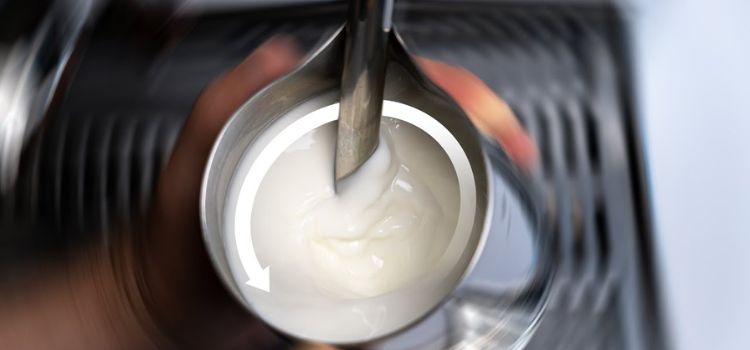As an Amazon Associate, I earn from qualifying purchases

In the world of coffee, the texture of milk can make or break your drink. Whether you’re a fan of lattes, cappuccinos, or macchiatos, the type of milk you use plays a crucial role in the flavor, appearance, and overall enjoyment of your beverage.
Choosing between steamed milk and frothed milk is more than just a matter of preference; it’s about understanding how each type contributes to the coffee experience. In this article, we’ll delve into the differences between steamed and frothed milk, their uses, and how you can master them at home.
Milk texture is an essential element in creating the perfect coffee drink. It affects not only the taste but also the presentation of your beverage. A smooth, creamy latte or a light, airy cappuccino owes its appeal to the texture of the milk.
Both steamed and frothed milk are popular choices in coffee shops worldwide, each bringing its unique qualities to the table. Understanding these can help you make better choices at your local café or even elevate your coffee-making skills at home.
What is Steamed Milk?

Steamed milk is milk that has been heated with steam to create a smooth, velvety texture. This process involves incorporating microfoam, which is a collection of tiny bubbles that give the milk its creamy consistency. Steamed milk is an integral part of many popular coffee drinks, adding a rich, luxurious feel that pairs beautifully with espresso.
Characteristics of Steamed Milk
Steamed milk is known for its silky texture and subtle sweetness. The heating process not only warms the milk but slightly alters its natural sugars, enhancing the flavor profile. The microfoam created during steaming is finer and denser than that in frothed milk, making it ideal for creating intricate latte art.
Common Uses in Coffee Drinks
Steamed milk is most commonly used in:
- Lattes: With a higher ratio of milk to coffee, lattes are creamy and smooth, making them a favorite morning indulgence.
- Flat Whites: Similar to lattes but with a stronger coffee flavor, flat whites feature a thin layer of microfoam.
- Café Au Lait: A simple yet satisfying mix of brewed coffee and steamed milk, perfect for those who prefer a milder coffee taste.
What is Frothed Milk?

Frothed milk, on the other hand, is created by introducing air into milk until it becomes light and airy with larger, more distinct bubbles. This process results in a foam that is less dense than steamed milk, adding a unique texture and flavor to coffee drinks.
Characteristics of Frothed Milk
Frothed milk is characterized by its light, fluffy texture and the visible bubbles that form during frothing. The airiness of frothed milk makes it a great topping for coffee, adding volume without overwhelming the base flavors. Its airy quality also means it tends to sit on top of the drink rather than blending into it.
Common Uses in Coffee Drinks
Frothed milk is typically used in:
- Cappuccinos: Known for their equal parts espresso, steamed milk, and frothed milk, cappuccinos offer a balanced mix of flavors and textures.
- Macchiatos: These are espresso drinks “marked” with a dollop of frothed milk, providing a strong coffee taste with a hint of creamy texture.
- Espresso Con Panna: A shot of espresso topped with a generous layer of frothed milk, offering a rich yet airy coffee experience.
Comparison of Steamed Milk and Frothed Milk

When comparing steamed milk and frothed milk, several factors come into play, including texture, taste, and best uses. Understanding these differences can help you choose the right milk for your coffee creation.
Texture Differences
- Steamed Milk: This type of milk is dense and creamy, characterized by fine microfoam that is meticulously created through the steaming process. The result is a smooth, velvety texture that integrates seamlessly with espresso, enhancing the overall mouthfeel of the drink. The fine microfoam also helps create beautiful latte art, making it a favorite among baristas.
- Frothed Milk: In contrast, frothed milk is light and airy, featuring larger bubbles that contribute to a foamier texture. This texture is less integrated with the espresso, resulting in a more pronounced separation between the milk and coffee. The airy nature of frothed milk often leads to a playful, whimsical presentation in beverages, making it visually appealing.
Taste Variations
- Steamed Milk: The heating process involved in steaming milk caramelizes the natural sugars present in the milk, significantly enhancing its inherent sweetness. This transformation creates a richer, more complex flavor profile that pairs beautifully with coffee, making it an essential component in beverages like lattes and flat whites. The warmth also brings out subtle dairy notes, enriching the overall taste experience.
- Frothed Milk: While frothed milk is also sweet, the introduction of air can dilute the creaminess, resulting in a lighter, more delicate taste. This variation can be refreshing but may lack the depth that steamed milk provides. The taste can vary depending on the amount of foam, with some froths being more pronounced than others, adding an interesting dynamic to the flavor profile of drinks like cappuccinos and macchiatos.
Best Uses for Each
- Steamed Milk: Steamed milk is best suited for drinks where a smooth, rich texture is desired, such as lattes and flat whites. Its ability to blend effortlessly with espresso makes it the perfect choice for those looking to enjoy a harmonious drink that emphasizes creaminess and warmth. The luxurious mouthfeel enhances the drinking experience, making it a popular option for coffee lovers.
- Frothed Milk: On the other hand, frothed milk shines in beverages where foam is a key feature, such as cappuccinos and macchiatos. The airy texture adds a playful element to these drinks, providing a delightful contrast to the strong flavors of the espresso. The foam also serves as a barrier that retains heat, helping to keep the beverage warm for longer, while adding an enticing visual appeal that invites enjoyment.
Tips for Making Steamed and Frothed Milk at Home
Creating the perfect steamed or frothed milk at home requires the right equipment and techniques. Whether you have a professional espresso machine or simple kitchen tools, you can achieve great results with practice.
Equipment Needed
- Steam Wand: Found on espresso machines, this tool is essential for creating authentic steamed milk.
- Milk Frother: An electric frother can quickly whip up frothed milk with the push of a button.
- Manual Tools: A whisk or French press can also be used to froth milk if you don’t have specialized equipment.
Step-by-Step Instructions
- Steamed Milk: Use a steam wand to heat the milk, keeping the tip just below the surface to create microfoam. Move the wand in a circular motion until the milk reaches the desired temperature and texture.
- Frothed Milk: Use a frother or whisk to incorporate air into the milk, moving in a consistent circular motion until frothy. For a French press, pump the plunger up and down until the milk reaches the desired frothiness.
Best Types of Milk to Use
- Cow’s Milk: Whole milk is preferred for its higher fat content, which adds creaminess. However, 2% and skim milk can also be used for a lighter option.
- Non-Dairy Alternatives: Options like almond, oat, and soy milk can be frothed, though results may vary based on the brand and formulation.
Conclusion
Steamed milk and frothed milk each bring something unique to the world of coffee, enhancing both flavor and presentation. Understanding their differences and learning how to make each at home can improve your coffee-making skills and allow you to enjoy café-quality beverages without leaving your kitchen.
Experiment with both types of milk to find your preferred texture and taste, and don’t be afraid to try new techniques and recipes. With practice, you’ll be able to create stunning coffee drinks that rival those of your favorite café, all from the comfort of your home. Enjoy the process, savor the results, and elevate your coffee experience with the perfect milk texture.
As an Amazon Associate, I earn from qualifying purchases